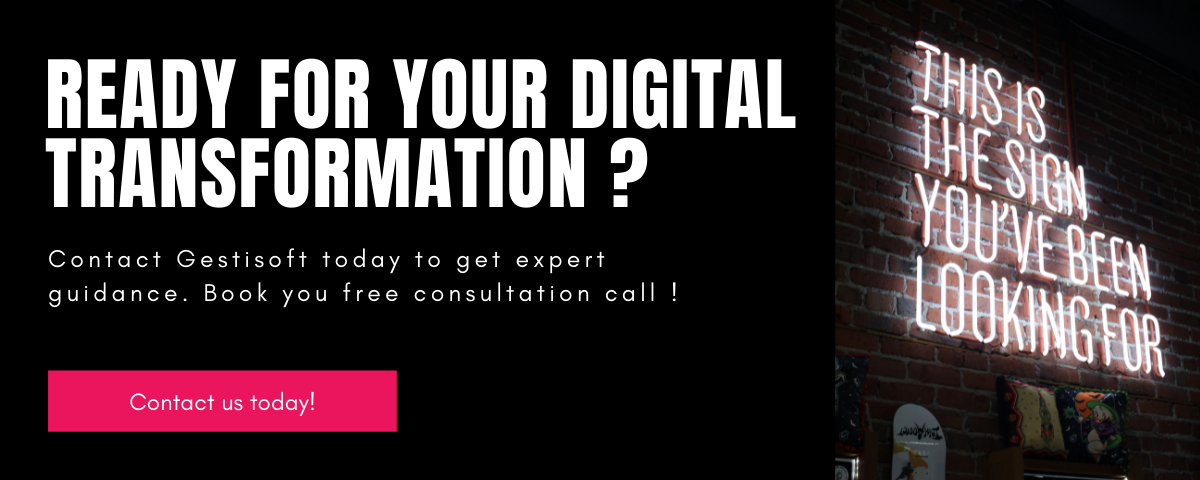There's not doubt that technology holds the key to success. Staying ahead of the curve isn't just a choice but a necessity. Embracing change and embarking on a digital transformation journey is your passport to thriving in this dynamic landscape. And when it comes to the perfect way for this transformative adventure, look no further than Microsoft Catalyst.
Imagine having the wisdom and resources at your fingertips to understand your current position, pinpoint areas of improvement, and craft a tailored path to digital transformation. Microsoft Catalyst makes this vision a reality.
Keep on reading to learn how Microsoft Catalyst can help you tailor success. From harnessing its potential to tracking your progress, let's embark on a journey where the extraordinary becomes achievable.
Understanding the Need for Digital Transformation
On top of everyday obligations, businesses are expected to keep an eye on emerging technology and their potential impact on digital transformation efforts. Technologies such as artificial intelligence, machine learning, virtual and augmented reality are all transforming the way an organization operates and interacts with customers. Keeping informed about these developments can help companies stay competitive in a rapidly changing digital era.
The Crucial Role of Digital Transformation
Digital transformation isn't just a trend — it's an imperative! It's the process through which businesses evolve their operations, strategies, and customer experiences to conform to the requirements of this digital age. For those who embark on this transformative journey, the rewards are boundless. But success requires more than merely embracing change — it demands careful planning, strategic vision, and a deep understanding of trends.
Tailoring Transformation to Your Business
There's no one-size-fits-all solution to digital transformation success. Each organization is unique, with its own set of challenges, opportunities, and goals. To navigate this terrain successfully, companies should develop a tailored strategy that considers every facet of their business model. With the right approach and commitment to innovation, organizations can reap the rewards associated with successful digital transformation initiatives.
Microsoft Catalyst: Your Key to Digital Transformation Excellence
Microsoft Catalyst is an exceptional program designed to be your trusted companion on the journey of digital transformation. Guided by a certified partner, you'll be leveraging the power of Microsoft Dynamics 365, the Microsoft Power Platform, and the Microsoft Cloud. At its core, Catalyst is built upon a transformative framework known as I.D.E.A., representing the stages of Inspire, Design, Empower, and Achieve.

Inspire: Igniting the Transformation Spark
At the Inspire stage, we work alongside your organization to kindle the flames of innovation. Our goal is to help you identify and prioritize a transformation strategy that aligns seamlessly with your unique needs and aspirations. Through a series of development activities and visionary workshops, we foster ideation, encourage collaborative decision-making, and set the stage for the remarkable journey ahead.
Design: Crafting a Vision of Change
In the Design phase, we collaborate with you to craft a compelling narrative for change. Together, we explore the profound impact of your strategy, both from a business and technological standpoint. Our toolbox includes robust tools like the Business Value Assessment and Solution Assessment, allowing us to quantify the return on investment and financial benefits that your transformation promises to deliver.
Empower: Forging Engagement and Commitment
Empowerment is about creating a shared vision and securing buy-in from all stakeholders. We employ immersive experiences and visual assets to showcase the value of your transformation journey. Through tools such as solution demonstrations and captivating business transformation stories, we ignite enthusiasm, foster engagement, and rally your team around the common goal of change.
Achieve: Turning Vision into Reality
In the Achieve phase, we transition from envisioning to execution. We provide you with the necessary resources to implement your strategy seamlessly across all departments. Our toolkit includes deal-crafted proposals and meticulous project plans, making sure that your transformation initiative unfolds with precision and results in a resounding success.

Using Catalyst's Framework For Assessing Current Capabilities
In the realm of digital transformation, assessing organizational needs is akin to charting a course before embarking on a grand voyage. It's about understanding your organization's current position, strengths, and weaknesses, all while envisioning the destination you aim to reach. Microsoft Catalyst serves as your compass in this endeavor.
Understanding Organizational Needs
Assessing organizational needs in the context of digital transformation means comprehending the unique landscape in which your business operates. It involves identifying the areas where your organization excels and where there's room for improvement. It's about recognizing the technological advancements and shifts in customer expectations that call for change.
Leveraging Microsoft Catalyst's Expertise
Microsoft Catalyst simplifies this process by providing a wealth of tools and resources specifically designed for this purpose. It offers a comprehensive assessment of your current digital capabilities, delving into aspects such as technology infrastructure, data analytics competence, and workforce skills. With Catalyst, you can use data analytics and machine learning to find opportunities and challenges during transformation.
The Crucial Role of Self-Assessment
Self-assessment is the keystone of any successful digital transformation strategy. It's the process through which you gain a clear understanding of where you stand, enabling you to make informed decisions about where you want to go. Without this crucial starting point, you risk embarking on a transformation journey without a roadmap leading to costly detours and misalignment with your organization's true goals.
Leveraging Catalyst's Insights To Identify Opportunities for Improvement
Microsoft uses data analytics and machine learning to provide data-driven insights. These insights are a treasure trove, revealing untapped potential, bottlenecks, and areas ripe for enhancement within your organization. By analyzing vast datasets, Catalyst identifies patterns, trends, and anomalies that might go unnoticed in traditional assessments.
Real-World Examples of Catalyst's Impact
Let's explore how Catalyst has been a catalyst for transformation in real-world scenarios:
Optimizing Supply Chain Efficiency
A manufacturing company using Catalyst analyzed its supply chain operations. The insights revealed inefficiencies in inventory management and distribution. The company used data to improve its supply chain and reduce costs. This led to faster delivery and higher customer satisfaction.
Enhancing Customer Experiences
A retail giant leveraged Catalyst to assess customer data. The insights unveil a drop in customer satisfaction levels due to delays in responding to customer inquiries. The company improved customer service by using chatbots and automated responses. This gives customers faster and more efficient support.
Accelerating Product Development
A technology startup used Catalyst's insights to evaluate its product development cycle. The data highlighted bottlenecks in the ideation phase. With this knowledge, the company restructured its innovation process, reducing time-to-market and introducing a range of successful products faster than ever before.
Employee Skills Enhancement
A professional services firm used Catalyst to analyze its workforce's skill sets. The insights revealed a gap in data analytics skills among its employees. To bridge this gap, the organization launched targeted training programs, enhancing employee capabilities and bolstering its data-driven decision-making.
These examples show how Microsoft Catalyst's data-driven insights improve business operations in different ways, leading to efficiency, customer satisfaction, innovation, and workforce development. By embracing these insights, organizations can make strategic decisions that drive growth and competitive advantage in the digital era.
Developing a Digital Transformation Strategy With Microsoft Catalyst
Organizations of all sizes can benefit from using Microsoft Catalyst to develop a comprehensive digital transformation strategy that'll help them stay competitive. With its suite of tools and resources, businesses can assess their current capabilities, identify areas for improvement, and create effective strategies tailored to their goals. This platform provides an ideal environment for developing a successful digital transformation plan that'll keep organizations ahead of the competition.

Understanding Your Business
Start with a Clear Picture: Before embarking on any transformation journey, it's essential to understand your organization inside and out. What are your goals? What challenges do you face? What strengths can you leverage? Take a deep dive into your business's DNA to set the stage for your transformation.
Setting Clear Objectives
Define Your Destination: To measure progress, you need clear objectives. Define what you want to achieve with your digital transformation and establish measurable goals. Make sure that these objectives align with your broader business vision and long-term strategy.
Identifying Key Stakeholders
Building Alignment: Transformation involves multiple stakeholders, from leadership to front-line employees. Identify the key players and make sure that there is buy-in and alignment across the organization. Leadership support is particularly crucial to driving change.
Leveraging Data-Driven Insights
Data as Your Guide: In the era of data, let insights be your guiding light. Microsoft Catalyst offers data-driven insights into your organization's digital landscape. It's not guesswork but evidence-based decision-making.
Personalizing Your Strategy
One Size Doesn't Fit All: Understand that each organization is unique. Your strategy should reflect your organization's culture, industry, and specific needs. Tailor it to fit like a glove, addressing your distinct challenges and opportunities.
Engaging Cross-Functional Teams
Collaborative Power: Collaboration is key. Engage teams across departments and break down silos to ensure that everyone is on the same page. Involve employees at all levels to foster commitment and ownership.
Selecting the Right Technologies
Technology Fit: Choose technologies that align with your strategy and objectives. Make sure they integrate smoothly with your existing systems and offer scalability as your organization grows.
Planning for Change Management
Navigating the Transition: Understand that change can be met with resistance. Develop a change management plan to guide employees through the transformation. Transparency and effective communication are paramount.
Measuring and Adapting
Progress Tracking: Establish key performance indicators (KPIs) to measure your transformation's progress and impact. Continuously track and adapt your strategy based on real-time data and feedback.
Fostering a Culture of Innovation
Embrace Innovation: Encourage a culture of continuous learning and innovation within your organization. Create an environment where experimentation and adaptation aren't only allowed but celebrated.
Best Practices and Tips
Leadership Commitment: Secure full leadership commitment and support for the transformation journey.
Cross-Functional Collaboration: Collaborate across departments to make sure holistic strategy alignment.
Employee Training: Invest in upskilling your workforce to meet the demands of the digital future.
Agility: Be ready to adapt your strategy to changing technologies and market dynamics.
Customer-Centricity: Keep the customer at the center of your strategy, focusing on enhancing their experience.
Data Security: Prioritize data security and privacy throughout the transformation.
Sustainability: Consider the environmental and social impact of your strategy and align with sustainability goals.
Crafting a tailored digital transformation strategy isn't a one-time effort but an ongoing journey. It requires strategic vision, adaptability, and a commitment to innovation. Follow these steps and use best practices to transform your organization's digital environment, so it stays flexible, adaptive, and aligned with your goals and vision. Embrace change, and let your organization thrive in the digital age.
Scaling for Tomorrow: Future-Proofing with Microsoft Catalyst
Digital transformation isn't a one-time endeavor — it's an ongoing process. As your organization grows and evolves, your digital strategy must keep pace. Scalability in this context refers to the ability to expand and adapt your digital initiatives as your business requirements change. It's about making sure that your transformation efforts can grow seamlessly alongside your organization.
Why Scalability Matters
Adapting to Growth: As your business grows, so do its digital needs. Scalability guarantees that your digital infrastructure and solutions can accommodate increased data, users, and processes without disruption.
Embracing New Technologies: The digital landscape is ever-changing, with new technologies constantly emerging. Scalability allows you to integrate these technologies into your existing framework, while staying at the forefront of innovation.
Enhancing Customer Experiences: Scalability enables you to continually enhance the customer experience. As your customer base expands, your digital capabilities should scale to meet their evolving expectations.
Future-Proofing for Success
Future-proofing your digital transformation strategy is essential for long-term success. Here are some key steps:
1. Embrace Innovation: Stay agile and open to new technology and trends. Regularly assess emerging technologies to identify opportunities for innovation.
2. Continual Learning: Invest in ongoing training and upskilling for your workforce to make sure they have the skills needed for the digital future.
3. Flexible Framework: Build your digital infrastructure and strategy with flexibility in mind. Make sure that it can adapt and grow as your organization evolves.
4. Data Security: Prioritize data security and privacy, safeguarding your organization against evolving threats.
5. Customer-Centricity: Keep the customers at the center of your strategy. Continually seek ways to enhance customer experience and meet their changing needs.
6. Monitor and Adapt: Continuously track the progress of your digital initiatives and adjust your strategy based on real-time data and feedback.
Gestisoft, through Microsoft Catalyst, is your partner in this transformative odyssey. It offers a proven, innovative approach that harnesses the full potential of Microsoft's products and services. Catalyst helps you embrace change, take advantage of opportunities, win more deals, and work better with Microsoft.
With Microsoft Catalyst, your organization doesn't just embark on a digital transformation journey — it embarks on a journey toward excellence, innovation, and a future where possibilities are boundless.
Let's Explore the Possibilities Together — Get in Touch!

Liked what you just read? Sharing is caring.

October 19, 2023 by Frédéric Charest by Frédéric Charest VP of Marketing
Data-driven Growth Marketer with a Passion for SEO - Driving Results through Analytics and Optimization



